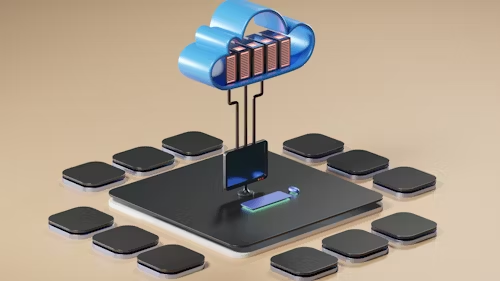Ever wondered where all your photos, files, and videos actually “live” when you upload them to the cloud? Spoiler: they don’t float around in the sky. They sit in massive data centers filled with thousands of humming servers; all drawing electricity, generating heat, and needing constant cooling.
Now, multiply that by billions of users. You start to see the picture: our digital life has a very real carbon footprint.
That’s where Green Cloud Computing comes in, the idea of running cloud systems in a way that’s kinder to the planet without sacrificing performance or reliability.
What Is Green Cloud Computing, Really?
Green cloud computing means running cloud services think storage, servers, and software using less energy and cleaner power sources.
Instead of relying on fossil fuels and inefficient systems, the green cloud uses renewable energy, efficient hardware, and smart technology to reduce pollution.
Think of it as the difference between driving a gas-guzzling truck versus an electric car, both get you where you need to go, but one is much better for the planet.
But it’s not just about being eco-friendly for the sake of it. Green cloud computing is also about cutting costs, future-proofing businesses, and building brand trust in a world that increasingly cares about sustainability.
Why the World Needs a Greener Cloud
1. The Cloud Isn’t Weightless
Data centers is the physical backbone of cloud computing, consume staggering amounts of power. In fact, they account for an estimated 2–3% of global electricity use, and that number is climbing fast.
That power often comes from non-renewable sources, meaning every time we stream a show, run an app, or back up photos, some emissions are released. Green cloud computing helps reduce that invisible pollution.
2. Climate Change Can’t Wait
Energy efficiency isn’t just a “nice to have” anymore, it’s a global priority. Every watt of power saved and every kilowatt-hour switched to renewable energy helps slow climate change.
Shifting data centers toward solar, wind, and hydro energy, cloud providers are taking real steps toward decarbonization.
3. Efficiency Saves Money
Running greener systems often means running smarter systems. Efficient cooling, modern hardware, and optimized workloads don’t just save the planet; they also save money on power bills.
4. Customers and Investors Expect It
Consumers today are more eco-aware than ever. They want to buy from and invest in companies that actually care about the planet.
Green credentials aren’t just PR. They’re a business asset. Choosing green cloud solutions, companies can attract conscious customers, meet ESG (Environmental, Social, and Governance) goals, and comply with growing sustainability regulations.
How Green Cloud Computing Actually Works

So how does the cloud get greener? Here are the main strategies that make it possible.
1. Powering Data Centers with Renewable Energy
This is the most obvious (and powerful) step: using solar, wind, hydroelectric, or geothermal power instead of fossil fuels. Tech giants are investing billions to make it happen. For example:
- Google Cloud aims to run entirely on carbon-free energy by 2030.
- Amazon Web Services (AWS) is targeting 100% renewable power by 2025.
- Microsoft Azure has pledged to become carbon negative within the same decade.
2. Cooling Smarter, Not Harder
Cooling servers can consume as much energy as running them. That’s why green cloud computing invests in smarter cooling systems such as:
- Liquid cooling: Instead of blasting air conditioners, some data centers use liquid immersion tanks to absorb heat more efficiently.
- AI-powered climate control: Artificial intelligence now predicts temperature changes and adjusts cooling dynamically.
- Free-air cooling: In cooler regions, outside air can do the job naturally; no AC needed.
3. Using Better Hardware
New-generation servers are more powerful and more efficient. They use less energy per computation and last longer. Other smart choices include:
- Solid-State Drives (SSDs) that consume less power than spinning hard disks.
- Low-power CPUs and GPUs optimized for cloud workloads.
- Server recycling programs where old machines are refurbished instead of trashed.
4. Software Optimization
Software plays a big role in sustainability. Efficient algorithms and cloud architectures can cut energy use drastically. For instance:
- Running apps on serverless platforms means the cloud spins up resources only when needed.
- Virtualization allows one physical server to run many virtual ones, reducing idle time.
- Load balancing spreads workloads across regions where renewable energy is abundant.
5. Transparency & Green Metrics
Modern cloud providers now let customers see their environmental impact. Dashboards show how much energy their workloads use, and what percentage comes from renewables.
This kind of transparency is crucial. It helps companies track progress toward carbon neutrality and hold providers accountable.
Examples of the Green Cloud in Action
1. Google Cloud:
Google was one of the first tech companies to go carbon neutral (way back in 2007). Its data centers now use AI to manage cooling automatically, saving millions of kilowatt-hours each year.
Microsoft Azure: Going Carbon Negative
Microsoft has committed not just to zero emissions, but to removing all the carbon it has ever emitted since 1975; a bold goal that includes greener data centers and energy-efficient chips.
2. Amazon Web Services (AWS):
AWS is one of the world’s largest corporate buyers of renewable energy. It’s on track to power all its data centers with renewables by 2025.
3. OVHcloud:
European provider OVHcloud uses a circular economy model, reusing and recycling old servers, and even reusing waste heat from data centers to warm nearby buildings.
These examples show the industry isn’t just talking about sustainability; it’s investing in it.
The Roadblocks and How to Overcome Them
No transformation is without challenges. Here are the key ones facing green cloud computing and how companies can address them.
1. High Upfront Costs
Installing renewable systems and upgrading hardware takes investment. But energy savings and tax breaks often offset these costs over time.
2. Renewable Energy Gaps
Not every country or region has easy access to clean energy yet. Cloud providers are solving this by investing in off-site renewable projects and energy credits.
3. Balancing Performance and Sustainability
Green setups must stay fast and reliable. Smart workload distribution and AI-driven resource management help maintain that balance.
4. Avoiding Greenwashing
Transparency matters. Providers should publish verified sustainability reports rather than vague claims. Customers should look for certifications and measurable data.
The Future of Green Cloud Computing
We’re only at the beginning. The next decade promises a wave of innovation that will redefine how technology and sustainability work together.
Imagine AI-driven energy optimization that fine-tunes data center operations in real time; squeezing every bit of efficiency from every watt. Edge computing will move processing closer to where data is created, slashing the energy wasted on long-distance transfers.
Carbon-aware software will intelligently route workloads to regions powered by the cleanest energy sources. And circular IT ecosystems will ensure that every piece of hardware is reused, recycled, or repurposed; nothing wasted, everything valued.

